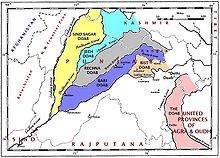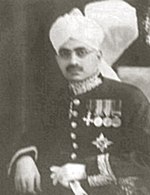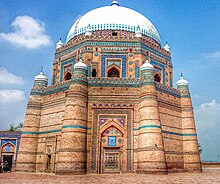Punjabi Muslims (Punjabi: پنجابی مسلمان) are adherents of Islam who identify ethnically, linguistically, culturally, and genealogically as Punjabis. With a population of more than 109 million,[4][5] they are the largest ethnic group in Pakistan and the world's third-largest Islam-adhering ethnicity[6] after Arabs[7] and Bengalis.[8] The majority of Punjabi Muslims are adherents of Sunni Islam, while a minority adhere to Shia Islam. They are primarily geographically native to the Punjab province of Pakistan, but many have ancestry from the Punjab region as a whole.
پنجابی مسلمان | |
|---|---|
| Regions with significant populations | |
| 111,303,000 | |
| 535,489[1] | |
| 500,000[2] | |
| 263,699[3] | |
| Languages | |
| Standard Punjabi, Western Punjabi and its dialects, Urdu | |
| Religion | |
(Sunni majority, Shia minority) | |
| Related ethnic groups | |
Forming the majority of the Punjabi ethnicity in the greater Punjab region[4] Punjabi Muslims speak or identify the Punjabi language (under a Perso-Arabic script known as Shahmukhi) as their mother tongue.
Identity
The coalescence of the various tribes, castes and the inhabitants of the Punjab region into a broader common "Punjabi" identity initiated from the onset of the 18th century CE.[9][10][11] However, Punjab as a linguistic, geographical and cultural entity had existed for centuries prior.[12] Integration and assimilation are important parts of Punjabi culture, since Punjabi identity is not based solely on tribal connections.[13] Islam spread in the region via missionary Sufi saints whose dargahs dot the landscape of the Punjab region thereby becoming the faith of many by the 16th century. This contributed to the formation of a Punjabi Muslim identity.[14][15][16][17]
History
Early period
At the advent of Islam in the seventh century, Punjab was part of Takka kingdom. By then, Buddhism had declined in Punjab after the fall of the Kushans, and had largely disappeared by the turn of the 10th century.[18] Several scholars have identified Takka kingdom with the kingdom of al-Usaifan, whose king is said to have converted to Islam by al-Biladhuri during the reign of Caliph al-Mu'tasim (r. 833–842).[19] However, Islam as a political power got introduced via southern Punjab only after the 8th century Umayyad conquest of Sindh. The first Muslim state in Punjab was the Emirate of Multan, established in 855 after the disintegration of the Abbasid Caliphate. In the 11th century, Muslim conquered northern Punjab after the defeat of the native Hindu Shahis by the Ghaznavids. The city of Lahore emerged as a thriving city, rivalling Ghazni and effectively acted as a second capital of the empire.[20][21]
In Punjab, conversion to Islam occurred mostly amongst pastoralist or agricultural groups that were not integrated into the Hindu Varna social class hierarchy,[14] such as Jats, who were known to Muslims as Zutt.[22] The tribes of the Bar region would be contacted by Sufi mystics like Fariduddin Ganjshakar over the centuries and converted to Islam, albeit a syncretic form. Gakhars of the Pothohar plateau were noted for their martial capabilities and gradually converted to Islam.[14]

Medieval period
In 1161, the Ghurids conquered the city of Ghazni, forcing the Ghaznavids to shift their capital to Lahore. Soon, however, Muhammad Ghori invaded Punjab as well, and conquered Lahore and Multan in 1186, marking end of the Ghaznavids. In 1206, he was assassinated at Damiak by Isma'ilis or Punjabi Khokhars.[23] One of his Mamluk slaves, Qutb ud-Din Aibak, established the Delhi Sultanate, with Lahore being the first capital of the sultanate. The early period of the Delhi Sultanate saw several Mongol invasions of Punjab. Ultimately, Mongols were defeated during the rule of the Khalji dynasty.[24]
Islam became firmly established in Punjab during the era of Delhi Sultanate, and tribes like Khokhars played an important role in the inter-dynastic struggle. In 1320, Ghazi Malik, the former governor of Multan, rebelled against the Khalji rule. With the support of various factions including Khokhars, he established the Tughlaq dynasty.[25][26] Some of the earliest mentions of Punjabi language date to this period.[27]

By the late 14th century, the Tughlaq dynasty had declined, and the sultanate was divided among various warlords. The city of Lahore was intermittently captured by Khokhars. Taking advantage of the prevailing anarchy, Timur led a brutal invasion of Delhi sultanate in 1398. Lahore had been under control of Shaikha Khokhar since 1394, who resisted Timur but was defeated and killed. Afterwards, Timur plundered Delhi and massacred its inhabitants.[29] Tughlaq power crumbled and resulted in nobles asserting formal independence. In 1414 the Tughlaq dynasty was itself replaced by Sayyid dynasty of Khizr Khan, a Punjabi chieftain.[30] Much of the time of Sayyid Sultans was spent in fighting against Jasrat, who was the most formidable opponent of Delhi sultans in Punjab. South Punjab became independent from Delhi when Langah Sultanate broke away in 1445.[31] The rulers of medieval Gujarat Sultanate in western India are also described as having Punjabi Khatri origins.[32]
Early modern period
Mughal Empire
By the early 16th century, the Lodi dynasty which succeeded Sayyids had control over little more than the region around Lahore in Punjab. In 1525, the Mughal emperor Babur invaded Delhi Sultanate and conquered it by defeating Ibrahim Lodi in the first battle of Panipat. The Gakhars of Potohar remained loyal to the house of Babur after Sher Shah Suri overthrew the Mughals under Humayun. This caused Sher Shah Suri to invade Pothohar and the local chief Sarang Khan died fighting against him.[33] However, Gakhars continued their resistance, even after Sher Shah Suri's minister Todar Mal constructed the Rohtas fort in the region.[34] Gakhar chiefs such as Kamal Khan were part of Mughal nobility when Humayun regained Delhi after defeating Sur dynasty in the Second Battle of Panipat.[35]
According to the Ain-i-Akbari written during the reign of Akbar, Punjab region was divided into Lahore and Multan provinces.[36] Muslims had majority in Punjab by the 16th century,[15] and a definitive Punjabi identity had formed as the inhabitants of Punjab started to be addressed as Punjabis by the outsiders during 17th century.[37] Several Punjabi Muslims rose to high ranks during Mughal period, such as Grand Vizier (Prime Minister) Saadullah Khan (1645–1656). He belonged to the Thaheem clan of Chiniot.[38] Saadullah Khan oversaw construction of several Mughal monuments including Taj Mahal under the supervision of architect Ustad Ahmad Lahori, who was also from Punjab, and led the Mughal army to Balkh in 1646 during Shah Jahan's war against the Safavids in the region.[39] Wazir Khan of Chiniot was also a grand vizier in the early Shah Jahani era.[40]
The death of Aurangzeb in 1707, began the decline of Mughal power in the 18th century. Between 1712 and 1719, Barhas, a dynasty of kingmakers of peasant origins from Punjab, exercised de-facto control over the Mughal Empire.[41] Mughal authority in Punjab remained in the hands of Nawabs who gave nominal allegiance to the Mughal emperor in Delhi; however it collapsed in Punjab after Mir Mannu died in 1753. Last Nawab of Punjab, Adina Beg was a Punjabi Arain who attempted to make Punjab independent. After his untimely death in 1758, Ahmad Shah Durrani directly annexed the region. Punjab suffered from the eight invasions of the Durrani Afghans between 1748 and 1767, which ravaged the region.[42]
During these centuries of Mughal rule, Punjabi Muslims established great institutions of Islamic civilization in cities and towns such as Lahore and Sialkot. Punjabi Muslim scholars were "in high demand", teaching the Islamic sciences as far as Central Asia, in cities such as Bukhara, even being considered there as Awliya' within their lifetimes.[43] The Kamboh clan of Lahore also produced many notable scholars and administrators. Other influential Muslim scholars born in Punjab during Mughal era include Abdul Hakim Sialkoti and Ahmad Sirhindi.[44] Between 1761 and 1799, the south Indian kingdom of Mysore was ruled by Hyder Ali, stated to be a Punjabi adventurer in the army of Mysore, and his son Tipu Sultan.[45][46] Tipu Sultan, who is widely hailed as a freedom fighter in South Asia, led Mysore during Anglo-Mysore Wars and also pioneered modern rocketry.[47]
Sikh Empire

Ahmad Shah Durrani and his successors failed to maintain control of Punjab except in Attock, Kasur and Multan where large Afghan colonies were based. Punjab was divided into petty Muslim and Sikh chieftancies. The situation remained as such till Ranjit Singh took Lahore in 1799.[48]
The two important Punjabi Muslim states that existed in 18th century Punjab were those of the Sials and the Gakhars. Gakhars under Sultan Muqarrab Khan (r.1738–1769) established rule over Potohar and the Chaj Doab whilst the Sials with their capital at Jhang conquered the Lower Rachna and Sindh Sagar Doabs under their chief Inayatullah Khan (r.1747–1787).[49] However, Sikhs, who originated in central Punjab, gradually expanded westwards. Owing to their superior European-style military training and discipline, the Sikhs under Ranjit Singh not only gained control of most of Punjab but also conquered Kashmir (1818), Multan (1818) and Peshawar (1833) from Durrani Afghans. Only the Bahawalpur state, then under Daudpotra Nawabs, remained independent from Sikh regime. With Ranjit Singh's death in 1839, Sikh power declined. After suffering defeat in the Anglo-Sikh wars, their territory was annexed in 1849 by the British East India Company.[50]
Views of the Sikh Empire rule, are mixed amongst different Punjabi Muslim groups. Ranjit Singh is seen favourably by a section of Punjabi activists in Pakistan but remains overall largely negative.[51] The mid 19th-century Punjabi Muslim historians, such as Shahamat Ali who experienced the Sikh Empire first hand, presented a different view on Ranjit Singh's empire and governance.[52][53] According to Ali, Ranjit Singh's government was despotic, and he was a mean monarch in contrast to the Mughals.[52] His account portrays Ranjit Singh as leading his Khalsa army's "insatiable appetite for plunder", their desire for "fresh cities to pillage", and eliminating the Mughal era "revenue intercepting intermediaries between the peasant-cultivator and the treasury".[54] As a symbolic assertion of power, the Sikhs regularly desecrated Muslim places of worship, including closing of the Jamia Masjid in Srinagar and the conversion of the Bad shahi Mosque in Lahore to an ammunition store and horse stable, but the empire still maintained Persian administrative institutions and court etiquette; the Sikh silver rupees were minted on the Mughal standard with Persian legends.[55][56]
Historian Robina Yasmin, on the other hand, argues against the stereotypical narratives of claimed anti-Muslim oppression by the Sikh Empire.[57] After researching contemporary sources held in the Fakir Khana archives in Pakistan and England, she concluded that the Sikh rulers were secular and allowed their Muslim subjects to freely practice their religion.[57] She also points out the fact that during the reign of the Sikh Empire in Punjab, there was never a single case of rebellion against the Sikh authorities by Muslims.[57] She further claims any beliefs of maltreatment of Muslims is based upon misunderstandings of the condition of the Muslim community during the Sikh Empire.[57]
Colonial period
Before British annexation of Punjab, the consciousness of a Punjabi identity was at its zenith.[37] Writing in 1840s, the Punjabi Muslim poet Shah Mohammad viewed Anglo-Sikh wars as war between the Punjab and Hind (India).[37] During colonial period, communal identity superseded regional one, and Punjabi Muslims increasingly disowned Punjabi language in the favour of Urdu in Persian script.[37]
War of Independence (1857)
The news of the Rebellion of 1857 reached Punjab quite late. Jhelum in Punjab saw a rebellion in which 35 British soldiers were killed on 7 July 1857. Among the dead was Captain Francis Spring, the eldest son of Colonel William Spring.[58] On 9 July, most of the brigade of sepoys at Sialkot rebelled and began to move to Delhi.[59] They were intercepted by John Nicholson with an equal British force as they tried to cross the Ravi River. After fighting steadily but unsuccessfully for several hours, the sepoys tried to fall back across the river but became trapped on an island, they were defeated by Nicholson in the Battle of Trimmu Ghat.[50]: 290–293 However, the main opponent of British rule in Punjab was Rai Ahmad Khan from Kharral clan who waged war against it for three months in central Punjab. He was killed on 21 September, 1857 in a skirmish with British colonial forces while inflicting heavy losses to the British.[60]
In the British Indian Army
Punjabi Muslims, classified as a "martial race" by the British colonialists,[61] made a substantial part of the British Indian Army, British academic David Omissi calling them the single largest group in both World Wars,[62] at the eve of World War II accounting for around 29% of its total numbers.[63]
However, there was also a history of popular resistance from Punjabi Muslims against British colonialism, including during the 1857 Indian Rebellion with the likes of Rai Ahmad Khan Kharal, facts which historian Turab-ul-Hassan Sargana says have been undermined because the elites of Punjab who collaborated with the British are those who still rule Pakistan today.[64]

Administrative reforms
The Government of India Act 1935 introduced provincial autonomy to Punjab replacing the system of dyarchy. It provided for the constitution of Punjab Legislative Assembly of 175 members presided by a Speaker and an executive government responsible to the Assembly. The Unionist Party under a Punjabi Muslim, Sir Sikandar Hayat Khan formed the government in 1937. Sir Sikandar was succeeded by Malik Khizar Hayat Tiwana in 1942 who remained the Premier till partition in 1947. Although the term of the Assembly was five years, the Assembly continued for about eight years and its last sitting was held on 19 March 1945.[65]
Majlis-e Ahrar-e Islam
During the 1930s and the 1940s, the Majlis-e Ahrar-e Islam, an anti-colonial Islamist political party founded in 1929 as an offshoot of the Khilafat Movement and a close collaborator of the Indian National Congress, became the dominant political force among Punjabi Muslims, especially among the lower middle echelons and the artisan classes, the Ahrar's having a diversity of Islamic schools but generally subscribed to a Deobandi interpretation with an Islamic socialist approach as well.[66]
After independence
During the Partition of 1947, millions also migrated from East Punjab to West Punjab to escape violence from Hindu and Sikh militias.[67] After independence, Punjabis formed the dominant ethnicity of Pakistan.
Culture
Sufism
Sufism has also played a major role in the history of Punjab.[68] Many prominent Sufi saints were born in Punjab, including Fariduddin Ganjshakar, Waris Shah and Bulleh Shah.[69][70]

Language
Punjabi Muslims had a major contribution in the development of Punjabi language. Fariduddin Ganjshakar (1179–1266) is recognised as the first major poet of the Punjabi language.[71] Roughly from the 12th century to the 19th century, many great Sufi saints and poets preached in the Punjabi language, the most prominent being Bulleh Shah. Punjabi Sufi poetry also developed under Shah Hussain (1538–1599), Sultan Bahu (1630–1691), Shah Sharaf (1640–1724), Ali Haider (1690–1785), Waris Shah (1722–1798), Saleh Muhammad Safoori (1747–1826), Mian Muhammad Baksh (1830–1907) and Khwaja Ghulam Farid (1845–1901).
Literature
The Punjabi language is famous for its rich literature of qisse, most of which are about love, passion, betrayal, sacrifice, social values and a common man's revolt against a larger system. The qissa of Heer Ranjha by Waris Shah (1706–1798) is among the most popular of Punjabi qissas. Other popular stories include Sohni Mahiwal by Fazal Shah, Mirza Sahiban by Hafiz Barkhudar (1658–1707), Sassui Punnhun by Hashim Shah (c. 1735–c. 1843), and Qissa Puran Bhagat by Qadaryar (1802–1892). In contrast to Persian poets, who had preferred the ghazal for poetic expression, Punjabi Sufi poets tended to compose in the Kafi.[72]
Music
Punjabi music is used by western musicians in many ways, such as mixing with other compositions. Sufi music and Qawali, commonly practiced in Punjab, Pakistan; are other important genres in the Punjab region.[73][74]
Folk music of Punjab is the traditional music of Punjab produced using traditional musical instruments like Tumba, Algoza, Dhadd, Sarangi, Chimta and more. There is a wide range of folk songs for every occasion from birth to death including marriage, festivals, fairs and religious ceremonies.
Demographics
Punjabi Muslims are found almost exclusively in Pakistan with 98% of Punjabis who live in Pakistan following Islam, in contrast to Punjabi Sikhs and Punjabi Hindus who predominantly live in India.[75] Thus religious homogeneity remains elusive as a predominant Sunni population with Shia, Ahmadiyya and Christian minorities.[76]
Numbers
While the total population of Punjab is 127 million as noted in the 2023 Pakistan census,[77][78] ethnic Punjabis comprise approximately 44.7% of the national population.[79][80] Ethnic Punjabis, that is, discounting the local Kashmiris, Pashtuns and Baloch residents, thus number approximately 111,303,000 million in Pakistan; this makes Punjabis the largest ethnic group in Pakistan by population.[79][80]
Tribes and clans
Punjabi Muslim society is centered around the concept of biraderi (برادری), social brotherhood within the tribe and clan.
The major tribes and clans among Punjabi Muslims are the Jats, Rajputs, Arains, Ansari, Sheikh, Gujjars and Awans.[81]
In his 1911-book The Armies of India, British major Sir George Fletcher MacMunn would write that Muslims of Punjab "are of many mixed races, but who largely consist of Rajput tribes converted to Islam at various times in the past."[82] As per the 1921 census, in the Punjab province of British India, comprising Pakistan's modern provinces of Western Punjab and some parts of Khyber Pakhtunkhwa as well India's modern states and union territories of Punjab, Haryana, Chandigarh, Delhi, and some parts of Himachal Pradesh, 70,7% of the Rajputs followed Islam while 27,7% were Hindus.[83]
See also
- History of Punjab
- List of Punjabi Muslims
- List of Punjabi Muslim tribes
- Jat Muslim
- Punjabi people
- List of Rulers of Pothohar Plateau
- Islam in Pakistan
- Punjabi Christians
- Punjabi Sikhs
- Punjabi Hindus
- Shahmukhi alphabet, the script used by Punjabi Muslims to read and write Punjabi